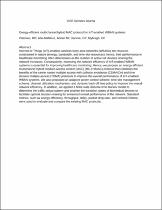JavaScript is disabled for your browser. Some features of this site may not work without it.
- ResearchSpace
- →
- Research Publications/Outputs
- →
- Journal Articles
- →
- View Item
| dc.contributor.author |
Olatinwo, DD

|
|
| dc.contributor.author |
Abu-Mahfouz, Adnan MI

|
|
| dc.contributor.author |
Hancke, GP

|
|
| dc.contributor.author |
Myburgh, HC

|
|
| dc.date.accessioned | 2024-01-26T12:39:54Z | |
| dc.date.available | 2024-01-26T12:39:54Z | |
| dc.date.issued | 2023-11 | |
| dc.identifier.citation | Olatinwo, D., Abu-Mahfouz, A.M., Hancke, G. & Myburgh, H. 2023. Energy-efficient multichannel hybrid MAC protocol for IoT-enabled WBAN systems. <i>IEEE Sensors Journal, 23(22).</i> http://hdl.handle.net/10204/13545 | en_ZA |
| dc.identifier.issn | 1530-437X | |
| dc.identifier.issn | 1558-1748 | |
| dc.identifier.uri | DOI: 10.1109/JSEN.2023.3322627 | |
| dc.identifier.uri | http://hdl.handle.net/10204/13545 | |
| dc.description.abstract | Internet-of-Things (IoT)-enabled wireless body area networks (WBANs) are resource-constrained in nature (energy, bandwidth, and time-slot resources); hence, their performance in healthcare monitoring often deteriorates as the number of active IoT devices sharing the network increases. Consequently, improving the network efficiency of IoT-enabled WBAN systems is essential for improving healthcare monitoring. Hence, we propose an energy-efficient multichannel hybrid medium access control (MAC) (MC-HYMAC) protocol that combines the benefits of the carrier sense multiple access with collision avoidance (CSMA/CA) and time division multiple access (TDMA) protocols to improve the overall performance of IoT-enabled WBAN systems. We also proposed an adaptive power control scheme, time-slot management scheme, channel utilization mechanism, and dynamic back-off time policy to improve the overall network efficiency. In addition, we applied a finite-state discrete-time Markov model to determine the traffic arrival pattern and analyze the transition states of biomedical devices to facilitate optimal decision-making for enhanced overall performance of the network. Standard metrics, such as energy efficiency, throughput, delay, packet drop ratio, and network lifetime, were used to evaluate and compare the existing MAC protocols. | en_US |
| dc.format | Abstract | en_US |
| dc.language.iso | en | en_US |
| dc.relation.uri | https://ieeexplore.ieee.org/document/10284585 | en_US |
| dc.source | IEEE Sensors Journal, 23(22) | en_US |
| dc.subject | Internet-of-things | en_US |
| dc.subject | IoT | en_US |
| dc.subject | Wireless body area networks | en_US |
| dc.subject | WBANs | en_US |
| dc.subject | Medium access control | en_US |
| dc.subject | MAC | en_US |
| dc.subject | Time division multiple access | en_US |
| dc.subject | TDMA | en_US |
| dc.title | Energy-efficient multichannel hybrid MAC protocol for IoT-enabled WBAN systems | en_US |
| dc.type | Article | en_US |
| dc.description.pages | 27967 - 27983 | en_US |
| dc.description.note | © 2023 IEEE. Due to copyright restrictions, the attached PDF file only contains the abstract of the full text item. For access to the full text item, please consult the publisher's website: https://ieeexplore.ieee.org/document/10284585 | en_US |
| dc.description.cluster | Next Generation Enterprises & Institutions | en_US |
| dc.description.impactarea | EDT4IR Management | en_US |
| dc.identifier.apacitation | Olatinwo, D., Abu-Mahfouz, A. M., Hancke, G., & Myburgh, H. (2023). Energy-efficient multichannel hybrid MAC protocol for IoT-enabled WBAN systems. <i>IEEE Sensors Journal, 23(22)</i>, http://hdl.handle.net/10204/13545 | en_ZA |
| dc.identifier.chicagocitation | Olatinwo, DD, Adnan MI Abu-Mahfouz, GP Hancke, and HC Myburgh "Energy-efficient multichannel hybrid MAC protocol for IoT-enabled WBAN systems." <i>IEEE Sensors Journal, 23(22)</i> (2023) http://hdl.handle.net/10204/13545 | en_ZA |
| dc.identifier.vancouvercitation | Olatinwo D, Abu-Mahfouz AM, Hancke G, Myburgh H. Energy-efficient multichannel hybrid MAC protocol for IoT-enabled WBAN systems. IEEE Sensors Journal, 23(22). 2023; http://hdl.handle.net/10204/13545. | en_ZA |
| dc.identifier.ris | TY - Article AU - Olatinwo, DD AU - Abu-Mahfouz, Adnan MI AU - Hancke, GP AU - Myburgh, HC AB - Internet-of-Things (IoT)-enabled wireless body area networks (WBANs) are resource-constrained in nature (energy, bandwidth, and time-slot resources); hence, their performance in healthcare monitoring often deteriorates as the number of active IoT devices sharing the network increases. Consequently, improving the network efficiency of IoT-enabled WBAN systems is essential for improving healthcare monitoring. Hence, we propose an energy-efficient multichannel hybrid medium access control (MAC) (MC-HYMAC) protocol that combines the benefits of the carrier sense multiple access with collision avoidance (CSMA/CA) and time division multiple access (TDMA) protocols to improve the overall performance of IoT-enabled WBAN systems. We also proposed an adaptive power control scheme, time-slot management scheme, channel utilization mechanism, and dynamic back-off time policy to improve the overall network efficiency. In addition, we applied a finite-state discrete-time Markov model to determine the traffic arrival pattern and analyze the transition states of biomedical devices to facilitate optimal decision-making for enhanced overall performance of the network. Standard metrics, such as energy efficiency, throughput, delay, packet drop ratio, and network lifetime, were used to evaluate and compare the existing MAC protocols. DA - 2023-11 DB - ResearchSpace DP - CSIR J1 - IEEE Sensors Journal, 23(22) KW - Internet-of-things KW - IoT KW - Wireless body area networks KW - WBANs KW - Medium access control KW - MAC KW - Time division multiple access KW - TDMA LK - https://researchspace.csir.co.za PY - 2023 SM - 1530-437X SM - 1558-1748 T1 - Energy-efficient multichannel hybrid MAC protocol for IoT-enabled WBAN systems TI - Energy-efficient multichannel hybrid MAC protocol for IoT-enabled WBAN systems UR - http://hdl.handle.net/10204/13545 ER - | en_ZA |
| dc.identifier.worklist | 27503 | en_US |






